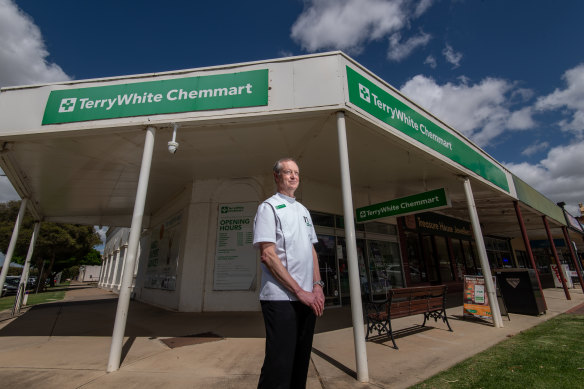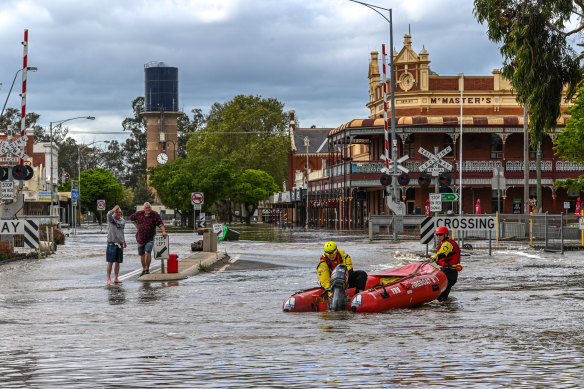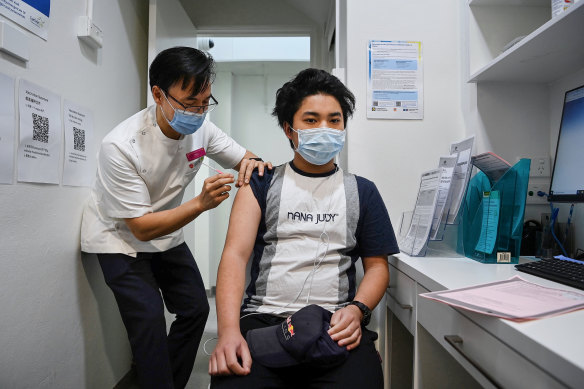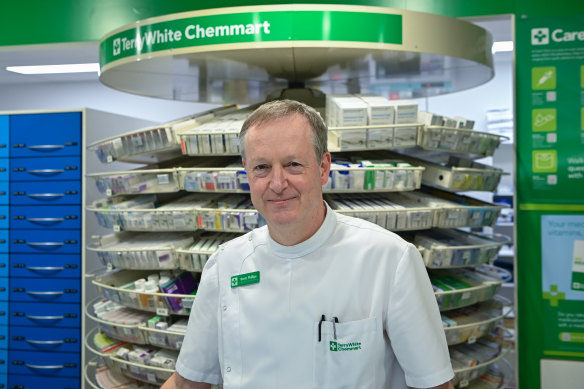Brett hasn’t had a holiday in five years. His community can’t afford him to
It has been more than five years since Brett Phillips took a holiday from running his pharmacy in the north Victorian town of Rochester. He is just too busy.
On a typically flat-out day this week, Phillips served more than 200 customers. He administered vaccines and dispensed a constant flow of medication. A woman came in seeking treatment for a redback spider bite. Another customer arrived with cold and flu symptoms and later tested positive for COVID-19.

Pharmacist Brett Phillips provides crucial healthcare in the town of Rochester. Credit: Justin McManus
Phillips has no time to stand still and jokes that he’ll stop for lunch about 5.30pm – closing time. Recently, one of two doctors surgeries closed in the town, which has added to Phillips’ workload.
He loves his work supporting the community’s wellbeing, but worries about how rural pharmacists will survive the myriad and mounting pressures coming their way.
“It’s challenging to get pharmacists to come and work in the country,” Phillips said. “I think it’s a wonderful, really rewarding way to work. But many people don’t.”
Rochester is still recovering from the devastating 2022 floods, and Phillips has provided crucial pastoral care.

Floodwaters in Rochester in 2022.Credit: Justin McManus
While the country doctor shortage is well known, the scarcity of pharmacists has attracted less attention. And Phillips is emblematic of a workforce crisis plaguing the sector.
The Pharmaceutical Society of Australia’s latest projections, from 2021, show there might be only 52 pharmacists per 100,000 people in regional and remote areas by 2027, compared with 113 per 100,000 people in major cities.
Monash Rural Health’s pharmacy liaison officer, Emily Griffin, said country communities depended more heavily on pharmacists than their city counterparts.
“Often they are the only healthcare provider in the town,” she said.

Pharmacists have delivered many COVID-19 vaccines - one an expanding number of services they are providing. Credit: Kate Geraghty
Griffin knows instances where rural pharmacists have had job openings for years, but been unable to attract applicants. In other cases, pharmacists cannot afford additional staff despite an unmanageable workload.
To combat the worsening pharmacy shortage, Griffin has designed a university program giving pharmacy students a taste of the rural life in the hope they will look beyond the big cities to launch their careers.
The program will give up to 12 students at a time the chance to spend about three weeks in a rural community, completing placements in retail pharmacies, hospitals and aged care centres, GP practices and medicine reviews with patients in their homes.
“If people haven’t had that experience, they’re not even going to contemplate it as an internship or career,” Griffin said.

Brett Phillips says he loves working in Rochester but worries about the future of pharmacy in country towns. Credit: Justin McManus
The first cohort of students will be placed in Mildura and Wonthaggi, followed by Rochester and Echuca.
The services community pharmacists can deliver has expanded under a trial allowing them to provide treatment for shingles and urinary tract infections and resupplying the contraceptive pill.
A spokeswoman for the federal Department of Health said it delivered nine programs to “incentivise” development of the rural and remote pharmacy workforce, providing $3.76 million in 2023-24 to students, interns, universities and pharmacies through the programs.
RMIT senior lecturer in pharmacy Dr Kate Wang said pharmacists were delivering a growing range of health services, and agreed more pharmacy students should spend time in country communities.
“It’s something that should be encouraged,” she said. “If they go on a two-week placement, it’s not permanent. If they like it, they might go out there after university to work.”
Despite the mounting pressures on his pharmacy, Phillips cannot imagine any other career.
“You know the saying: find a job you love, and you’ll never work a day in your life,” she said. “That’s sort of what I do.”
Start the day with a summary of the day’s most important and interesting stories, analysis and insights. Sign up for our Morning Edition newsletter.